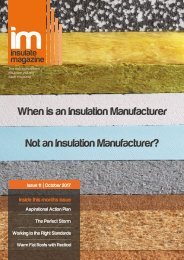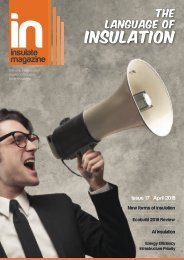Insulate Magazine Issue 12 - November 2017
The 1st Birthday issue of Insulate magazine titled "Round 12 with Recticel" features an exclusive interview with Recticel's commercial Director Kevin Bohea. If that wasn't enough we have a great exclusive inside the BBA, featuring an interview with BBA Chef Executive Richard Beale.
The 1st Birthday issue of Insulate magazine titled "Round 12 with Recticel" features an exclusive interview with Recticel's commercial Director Kevin Bohea. If that wasn't enough we have a great exclusive inside the BBA, featuring an interview with BBA Chef Executive Richard Beale.
You also want an ePaper? Increase the reach of your titles
YUMPU automatically turns print PDFs into web optimized ePapers that Google loves.
www.insulatenetwork.com<br />
The coldest recorded temperature in <strong>November</strong> last year<br />
(UK)is -9.7°C and the hottest recorded day in 2016 (UK)<br />
is 33.9°C.<br />
The complete 48-hour cycle is<br />
shown in the graph below:<br />
These temperature changes can lead to a door leaf bowing<br />
in its frame, which has an effect on the way it operates,<br />
and in extreme circumstances it will allow draughts<br />
to enter the home.<br />
Choosing the right material can have an enormous<br />
effect on the door’s performance. Different types of<br />
insulation infill can influence how the door reacts to<br />
changes in differential temperatures, so it’s important to<br />
test the product before it goes on the market.<br />
Test Services at the BBA has been using procedures<br />
that have been devised to determine the effect of thermal<br />
stress in the material build-up of doors, looking at<br />
the infill medium, thickness of reinforcement or PVC-U<br />
skin of a door leaf.<br />
As you’d expect, this involves Summer time testing and<br />
Winter time testing environments, to measure bow and<br />
defection of a door leaf inside its frame at different internal<br />
versus external temperature differentials.<br />
This helps to determine permanent defection of the door<br />
after extreme exposures, and to monitor any damage<br />
like cracking or splitting for example. The effort required<br />
to open and close the door, (operating forces),<br />
are recorded before and after exposure to ensure all the<br />
hardware functions correctly.<br />
The sample will then be allowed to return to ambient<br />
conditions before the operating forces are measured.<br />
As you’ll have gathered, the testing is extremely thorough<br />
with rigorous temperature applications applied in<br />
carefully simulated, real life conditions. It’s important to<br />
remember there’s a lot more to putting the wood in the<br />
hole than meets the eye. The good news is properly tested<br />
composite doors can contribute significantly to better<br />
and more sustainable insulation in homes up and down<br />
the country.<br />
Something to celebrate this Christmas<br />
The specimens are installed with their external face in<br />
an environmental chamber that is set to cycle between<br />
-10°C to +10°C. The internal face of the door leaf remains<br />
in the test laboratory ambient conditions. At periods<br />
of one hour during the positive temperature parts of<br />
the cycle, a 30 second water spray will be applied to the<br />
external face of the door.<br />
During the test, the deflection of the internal face of the<br />
door leaf is measured at the top and bottom corners of<br />
the locking edge.<br />
www.insulatenetwork.com<br />
27













